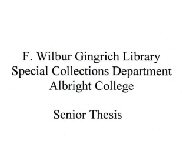Digital Collections

2003 Honors Theses
Total resources: 3
View: 2904
Browse resources

2004 Honors Theses
Total resources: 4
View: 2727
Browse resources

2006 Honors Theses
Total resources: 25
View: 5160
Browse resources

2007 Honors Theses
Total resources: 1
View: 7811
Browse resources

2008 Honors Thesis
Total resources: 6
View: 2541
Browse resources

2009 Honors Theses
Total resources: 20
View: 7856
Browse resources

2014 Honors Theses
Total resources: 18
View: 9439
Browse resources

2015 Honors Theses
Total resources: 27
View: 11412
Browse resources

2016 Honors Theses
Total resources: 27
View: 15133
Browse resources

2017 Honors Theses
Total resources: 30
View: 11849
Browse resources

2018 Honors Theses
Total resources: 31
View: 14252
Browse resources

2019 Honors Theses
Total resources: 111
View: 11814
Browse resources

2020 Honors Theses
Total resources: 3
View: 824
Browse resources

Aerial views
Total resources: 3
View: 3742
Browse resources

Albright Bulletin
Total resources: 148
View: 16710
Browse resources

Albrightian
Total resources: 440
View: 35458
Browse resources

Albrightian 1948 - 1965
Total resources: 352
View: 27581
Browse resources

Albrightian 1965 - 1975
Total resources: 196
View: 15534
Browse resources

Albrightian 1975 - 1987
Total resources: 194
View: 2932
Browse resources

Albrightian 1987 - 1995
Total resources: 115
View: 888
Browse resources
